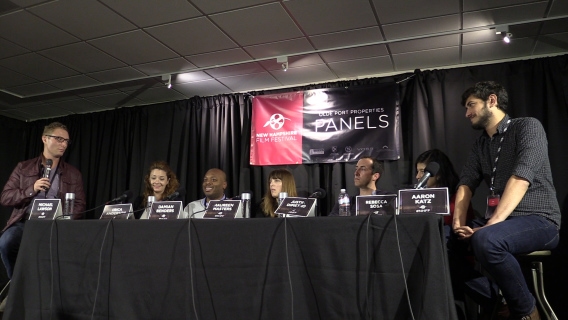Filmmaking and distribution in a digital world
The Insiders: Digital Distribution Panel, moderated by Michael Lawson, an Independent Distribution Consultant, included panelists Erica Anderson, Director of Crowdfunding & Community for Seed & Spark, Damian Benders, Senior Vice President of SnagFilms, Maureen Masters, Director of Regional Publicity at Magnolia Pictures, Justin Dipietro, Manager of Theatrical Sales for IFC Films, Rebecca Sosa, Head of Digital Distribution at A24 Films and Aaron Katz, Head of Acquisitions for Oscilloscope Laboratories. The panel discussed topics around Digital Distribution and touched on trends in viewing platforms, challenges and benefits as well as tricks and tips to making the most of the complex ecosystem that has risen around the digital distribution of film and television.
The filmmaking process does not stop when the film is completed; the most difficult aspect for some filmmakers is getting that film in front of audiences. Hand-in-hand with the advent of digital filmmaking has come the world of digital distribution, where viewers can choose from a seemingly infinite selection of materials and watch from the comfort of their own homes, or from mobile devices anywhere in the world at any given time.
According to Michael Lawson, over 40,000 films were submitted to festivals last year. Advances in capability and availability of film technology have vastly increased the number of films being made, so the challenge for both filmmakers and distributors lies in differentiating their films and putting them in front of the right audiences.
Damian Benders went on to explain that there are many platforms on which viewers can consume digital media, including Hulu and Netflix. These platforms are actively seeking new films in hopes of gaining viewership and offer an excellent opportunity for content creators of full-length features, shorts and episodic shows. Additionally, media can also be self-distributed online using platforms like VHX, Vimeo, as well as other solutions such as Tugg.com which can allow producers to screen their films at theaters.
Erica Anderson shared the importance of identifying the target audience and leveraging partnerships and organizations to get content to them.
“It’s not if you build it, they will come,” said Anderson.
Filmmakers and distributors need to take steps to make sure that their audience finds them. Part of the job of distribution is to handle “placement”, which refers to the visibility of a product to its consumers. Aaron Katz illustrated how iTunes offers the “Extras” feature, while Rebecca Sosa mentioned the “barker box” used by V.O.D (video-on-demand) solutions like Comcast OnDemand as an example of ways that digital distribution offers methods of placement, in which a preview or special promotional content can be displayed.
Digital excels at low-cost distribution, costing significantly less than 35mm film to produce. Filmmakers can make the most of it by keeping their film budget low and spending money on aspects that will draw the audience, such as well-known actors or excellent music, advised Erica Anderson. Another recommendation was to work with a distribution agent to identify opportunties, such as growing foreign markets where the audience may justify the expense of closed-captioning and international distribution.
To both appeal to audiences and stand out in the market it makes sense to leverage well-known genres, but make changes to the format to convey your message.
“Just shy of wild and crazy is better than truly wild and crazy,” Damian Benders added.
“As a filmmaker you will help yourself by thinking of yourself as an entrepeneur.”
Regarding the rise of digital distribution versus the decline of physical media like DVD and BlueRay, Michael Lawson said “more is more and more is better”, advising the use all avenues of distribution available to get in front of as many audience members as possible. Maureen Masters pointed out that DVDs can provide a second life for a film by reviving excitement with another release.
Digital distribution success stories are showing at the NHFF, including Boyhood and The Obvious Child, which was able to return to its KickStarter fans and leverage their enthusiasm to promote the film. Maureen Masters discussed how the digitally distributed film Blackfish has resulted in changes in practice and law involving sea creatures in captivity. The movie I Believe In Unicorns resulted in a grassroots organization and social media campaign which led to the formation of the Film Fatales group which deals with the intersection of film and feminism.
Although technology continues to change at a blinding pace and viewing trends are constantly developing, it is clear that digital distribution will only continue to grow and further enable independent filmmakers to create and share their work with ever-broadening audiences.
